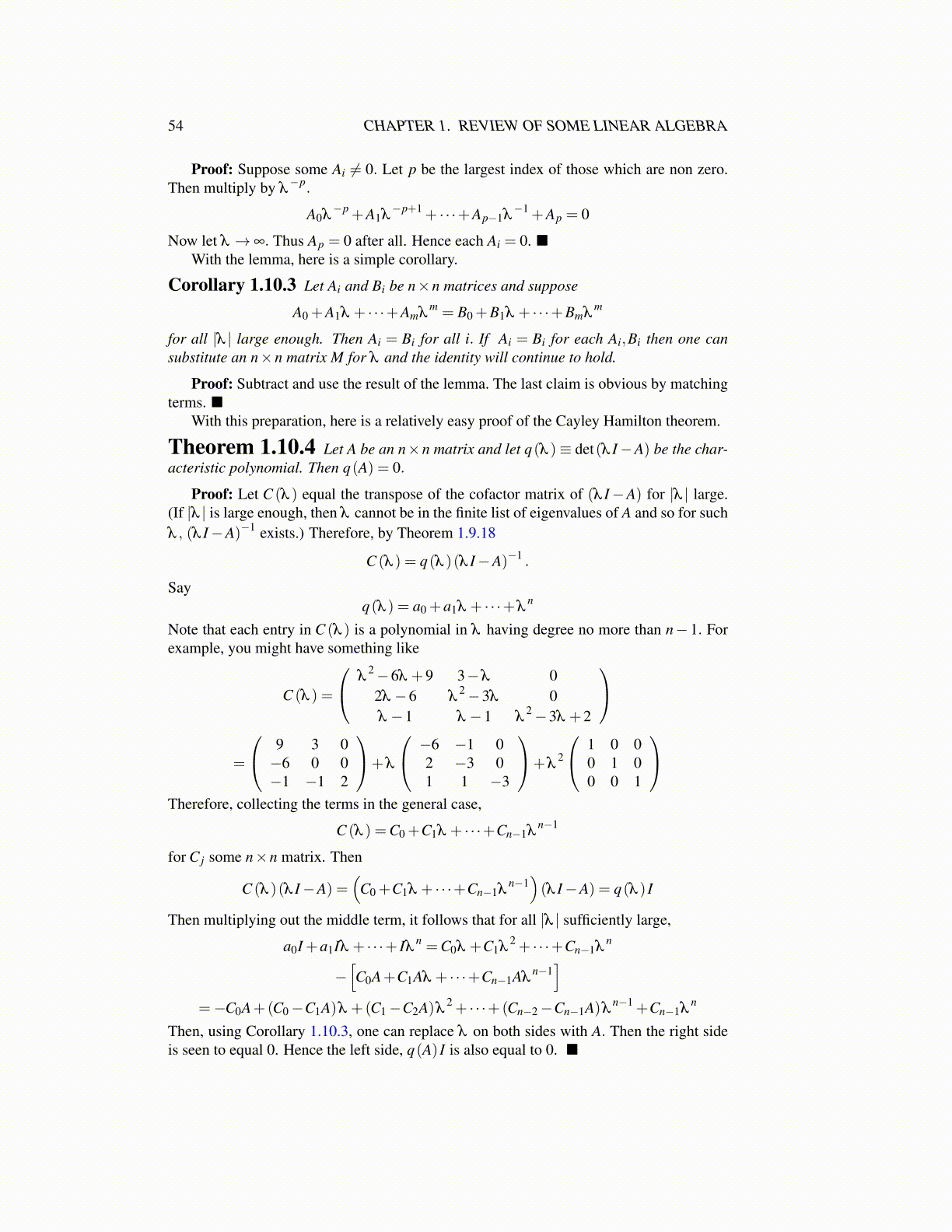
54 CHAPTER 1. REVIEW OF SOME LINEAR ALGEBRA
Proof: Suppose some Ai ̸= 0. Let p be the largest index of those which are non zero.Then multiply by λ
−p.
A0λ−p +A1λ
−p+1 + · · ·+Ap−1λ−1 +Ap = 0
Now let λ → ∞. Thus Ap = 0 after all. Hence each Ai = 0. ■With the lemma, here is a simple corollary.
Corollary 1.10.3 Let Ai and Bi be n×n matrices and suppose
A0 +A1λ + · · ·+Amλm = B0 +B1λ + · · ·+Bmλ
m
for all |λ | large enough. Then Ai = Bi for all i. If Ai = Bi for each Ai,Bi then one cansubstitute an n×n matrix M for λ and the identity will continue to hold.
Proof: Subtract and use the result of the lemma. The last claim is obvious by matchingterms. ■
With this preparation, here is a relatively easy proof of the Cayley Hamilton theorem.
Theorem 1.10.4 Let A be an n×n matrix and let q(λ )≡ det(λ I−A) be the char-acteristic polynomial. Then q(A) = 0.
Proof: Let C (λ ) equal the transpose of the cofactor matrix of (λ I−A) for |λ | large.(If |λ | is large enough, then λ cannot be in the finite list of eigenvalues of A and so for suchλ , (λ I−A)−1 exists.) Therefore, by Theorem 1.9.18
C (λ ) = q(λ )(λ I−A)−1 .
Sayq(λ ) = a0 +a1λ + · · ·+λ
n
Note that each entry in C (λ ) is a polynomial in λ having degree no more than n− 1. Forexample, you might have something like
C (λ ) =
λ2−6λ +9 3−λ 02λ −6 λ
2−3λ 0λ −1 λ −1 λ
2−3λ +2
=
9 3 0−6 0 0−1 −1 2
+λ
−6 −1 02 −3 01 1 −3
+λ2
1 0 00 1 00 0 1
Therefore, collecting the terms in the general case,
C (λ ) =C0 +C1λ + · · ·+Cn−1λn−1
for C j some n×n matrix. Then
C (λ )(λ I−A) =(
C0 +C1λ + · · ·+Cn−1λn−1)(λ I−A) = q(λ ) I
Then multiplying out the middle term, it follows that for all |λ | sufficiently large,
a0I +a1Iλ + · · ·+ Iλn =C0λ +C1λ
2 + · · ·+Cn−1λn
−[C0A+C1Aλ + · · ·+Cn−1Aλ
n−1]
=−C0A+(C0−C1A)λ +(C1−C2A)λ2 + · · ·+(Cn−2−Cn−1A)λ
n−1 +Cn−1λn
Then, using Corollary 1.10.3, one can replace λ on both sides with A. Then the right sideis seen to equal 0. Hence the left side, q(A) I is also equal to 0. ■